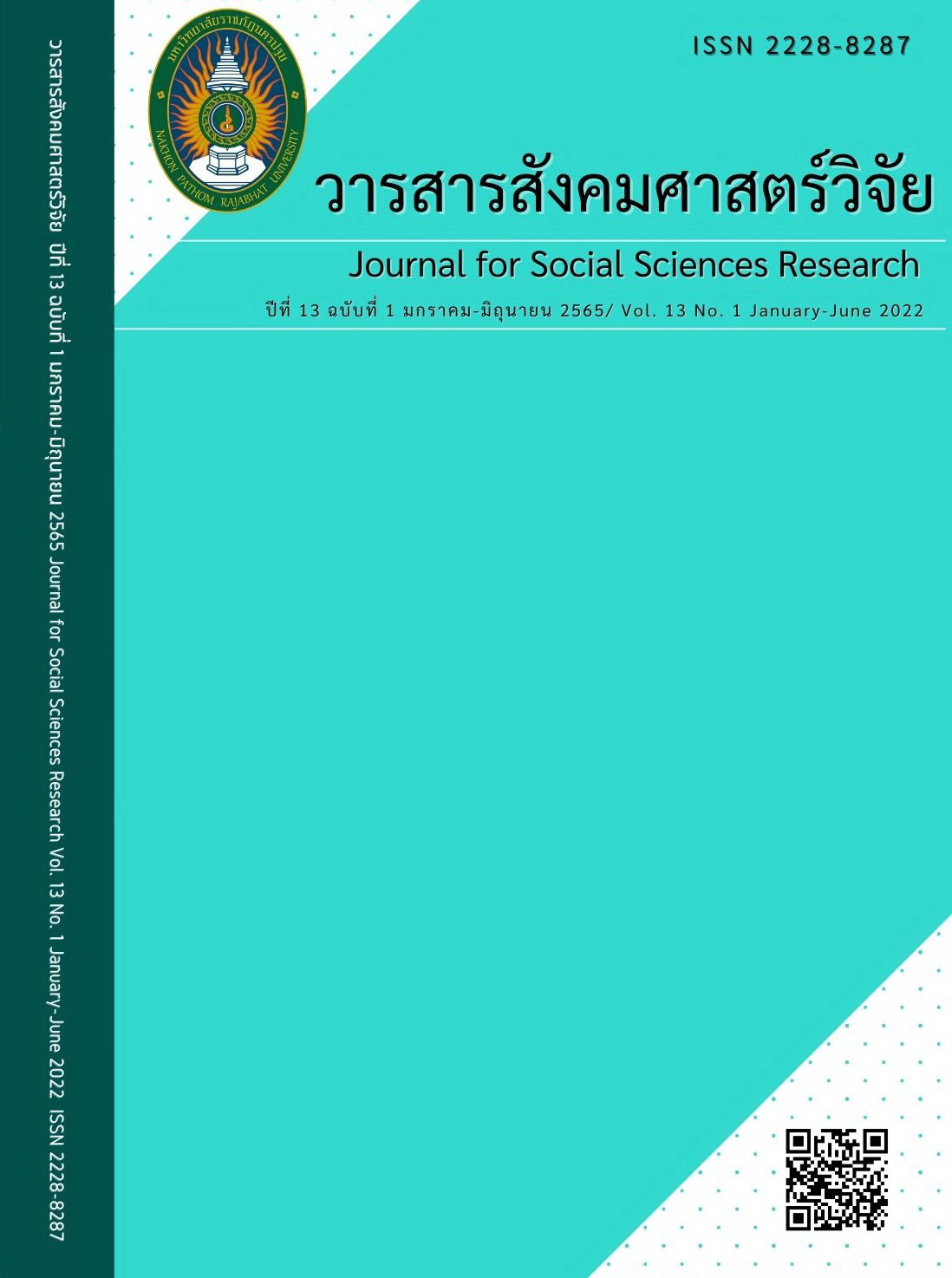MARKETING MIX FACTORS AFFECTING CONSUMER BEHAVIOR OF FRESHLY SQUEEZED ORANGE JUICE CONSUMPTION
Main Article Content
Abstract
The objectives of this study were to: 1) study the marketing mix factors of freshly squeezed orange juice; 2) investigate consumer behavior of freshly squeezed orange juice; 3) compare the consumer behavior of freshly squeezed orange juice classified by personal data; and 4) study the marketing mix factors influencing the consumer behavior of freshly squeezed orange juice. The sample of 400 customers was selected using purposive sampling. Questionnaires were used as a study tool. The statistics used for data analysis were frequency, percentage, mean, standard deviation, t-test, chi-square, one–way ANOVA, and multiple regression analysis. The findings of this research indicated as follows: 1) Overall and in specific aspects, the marketing mix factor of freshly squeezed orange juice consumption was at a high level. 2) Most of the consumers selected freshly squeezed orange juice because of the taste. The consumers mostly purchased freshly squeezed orange juice at the convenience/department stores. The cost of each purchase was less than or equal to 50 baht, and the quantity or size of purchase was 150 cc. The consumers made purchasing decisions by themselves. The time for drinking freshly squeezed orange juice was in the afternoon (12.01-15.00). The average purchase was twice a week and three bottles per time. 3) The consumers with differences in gender had different behavior in person influencing purchasing decisions and purchase time. Those with differences in ages had different behavior in reason of purchase, place of purchase, and drinking time. The consumers with differences in occupation had different behavior in place of purchase, quantity or size of purchase, and drinking time. Moreover, the consumers with differences in education had different behavior in reason of purchase and quantity or size of purchase; while those with differences in monthly income had different behavior in place of purchase and cost of each purchase. 4) The marketing mix factors of distribution (X3) significantly influenced the consumption behavior of freshly squeezed orange juice in purchase frequency per week (Y) at the .05 level.
The forecasting equation in raw scores was Y = .076 + .269X3.
The forecasting equation in standard form was Z = .151X3.
Article Details
บทความที่ได้รับการตีพิมพ์เป็นลิขสิทธิ์ของมหาวิทยาลัยราชภัฏนครปฐม
เนื้อหาของแต่ละบทความเป็นทัศนะของผู้เขียน ซึ่งที่ปรึกษา บรรณาธิการ กองบรรณาธิการ และคณะกรรมการบริหารวารสารไม่จำเป็นต้องเห็นด้วย หรือร่วมรับผิดชอบใดๆ
References
ชนินทร โฉมศรี. (2561). กระบวนการตัดสินใจเลือกซื้อน้ำผลไม้คั้นสดของผู้บริโภคในเขตกรุงเทพมหานคร. วิทยานิพนธ์บริหารธุรกิจมหาบัณฑิต สาขาวิชาการจัดการ บัณฑิตวิทยาลัย มหาวิทยาลัยรามคำแหง.
เดอะ โมเมนตัม (The momentum). (2561). “ส้ม” พืชตระกูลซีตรัสที่พัฒนาและกลายพันธุ์จนอร่อยมาถึงเราทุกวันนี้. ค้นเมื่อ 5 กุมภาพันธ์ 2565, จาก https://themomentum.co/kitchenpedia-oranges
ปรมะ สตะเวทิน. (2546). การสื่อสารมวลชน: กระบวนการและทฤษฎี (พิมพ์ครั้งที่ 3). กรุงเทพฯ: ภาพพิมพ์.
ภิญรดา แก้วเขียว. (2562). การพัฒนาเครื่องดื่มประเภทน้ำผลไม้สำหรับตลาดกลุ่มคนรุ่นใหม่. วิทยานิพนธ์บริหารธุรกิจมหาบัณฑิต สาขาวิชาการวางแผนและการจัดการเชิงกลยุทธ์ คณะบริหารธุรกิจ สถาบันเทคโนโลยีไทย-ญี่ปุ่น.
มณีรัตน์ ใจน้อย. (2560). กระบวนการตัดสินใจเลือกซื้อน้ำผลไม้ทิปโก้ ของคนในกรุงเทพมหานคร. วิทยานิพนธ์บริหารธุรกิจมหาบัณฑิต สาขาวิชาการจัดการ บัณฑิตวิทยาลัย มหาวิทยาลัยรามคำแหง.
มาร์เก็ต อินเทลลิเจนท์ (Market Intelligence). (2562). อาหารเครื่องดื่มเพื่อสุขภาพและความเป็นอยู่ที่ดีในประเทศไทย. ค้นเมื่อ 7 กุมภาพันธ์ 2565, จาก http://fic.nfi.or.th/MarketOverviewDomesticDetail.php?id=271
วิจิตรา ประเสริฐธรรม. (2556). พฤติกรรมการตัดสินใจซื้อน้ำผลไม้พร้อมดื่มของผู้บริโภคในเขตกรุงเทพมหานคร. วิทยานิพนธ์บริหารธุรกิจมหาบัณฑิต สาขาวิชาการตลาด บัณฑิตวิทยาลัย มหาวิทยาลัยราชภัฏสวนดุสิต.
วิภาวี สุริโย. (2558). ปัจจัยที่มีอิทธิพลต่อพฤติกรรมการซื้อน้ำผัก-น้ำผลไม้พร้อมดื่มของผู้บริโภคในเขตกรุงเทพมหานคร. วิทยานิพนธ์บริหารธุรกิจมหาบัณฑิต สาขาวิชาบริหารธุรกิจ บัณฑิตวิทยาลัย มหาวิทยาลัยธุรกิจบัณฑิตย์.
สรสิช พวงสุวรรณ, วรัท วินิจ และเอก บุญเจือ. (2563). อิทธิพลของประเภทผลิตภัณฑ์น้ำส้มแท้ร้อยเปอร์เซ็นต์ ต่อการรับรู้คุณประโยชน์ ความเป็นธรรมชาติ และความน่าเชื่อถือ. ใน การประชุมวิชาการระดับนานาชาติและระดับชาติด้านบริหารธุรกิจและการบัญชี ปี 2563 (20 กุมภาพันธ์ หน้า 150-162). เชียงใหม่: มหาวิทยาลัยเชียงใหม่.
เสรี วงษ์มณฑา. (2552). การวิเคราะห์พฤติกรรมผู้บริโภค. กรุงเทพฯ: ธีระฟิล์มและไซเท็กซ์.
อรุณโรจน์ เอกพณิชย์. (2558). ปัจจัยที่มีอิทธิพลต่อการเลือกซื้อน้ำผักและผลไม้อินทรีย์แบบสกัดเย็นของผู้บริโภคในเขตกรุงเทพมหานครและปริมณฑล. วิทยานิพนธ์บริหารธุรกิจมหาบัณฑิต สาขาวิชาบริหารธุรกิจ คณะพาณิชยศาสตร์และการบัญชี มหาวิทยาลัยธรรมศาสตร์.
Cochran, W. G. (1977). Sampling techniques (3rd ed.). New York: John Wiley & Sons.
Kotler, P. (2014). Marketing management (14th ed.). New Jersey: Prentice-Hall.


